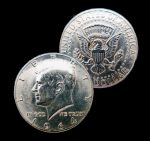As a boy, I can remember my grandfather, Ernest E. Rawles, saying to me: “If you consistently save ten percent of what you earn, then you’ll never go to The Poor House.” That was great advice, coming from someone who had lived through the truly traumatic deflationary Great Depression of the 1930s.
But today, we can see the looming threat of another economic depression, and this one will most likely be a traumatic inflationary depression. And this one may last even longer than a decade. In an inflationary depression, even millions of dollars in “savings” in cash (that is: greenbacks or digits on deposit in a bank) will not carry you through. Once general price inflation roars up into the double digits, we will see the purchasing power of our Dollars melt away. At a 25% annualized inflation rate, a $20 bill that would have bought 50 pounds of grain a year ago will only buy you 37.5 pounds. And 28.1 pounds the next year. And 21 pounds the third year. And what if general price inflation heats up to 50% or 150%, or higher? Instead of saying: “Cash is king”, people will be saying: “Cash is trash.”
Just ask anyone who has lived our toured an inflation-wracked country what it was like. Zimbabwe, Indonesia, and Venezuela are some recent examples. When wages don’t keep up with mass inflation, there is genuine suffering. In such times, anyone on a fixed income will be wiped out, very quickly. Sadly, given the chronic over-spending by western governments, it appears that destruction through mass inflation will be the fate of all of the world’s major currencies in the 2020s and 2030s.
Mitigating Inflation Threats
To be ready for inflationary times, we need to adopt a much different outlook on saving, spending, and investing. In times of inflation “money in the bank” will be a liability, not an asset. Barterable tangibles [1] will be an asset that constitutes an investment. Think of cash savings like holding a handful of sand. Over time, it will eventually slip through your fingers. In a truly hyperinflationary period, each time that you receive a paycheck, you will be in a rush to spend it on groceries, fuel, and other essential tangibles before that currency loses too much value.
The Cryptos Are Coming
It is very likely that the majority of national governments will replace their paper currencies with sovereign cryptocurrencies before 2030. Unlike private cryptos which provide wonderful opacity (privacy) for transactions, sovereign cryptocurrencies will have full transparency for every transaction. It can all be cataloged, tracked, regulated, and taxed. If there is ever rationing of goods, then your crypto account can lock you out of making “too many” purchases of tangibles. Or, if you are declared an enemy of the state or otherwise persona non grata, then your crypto account could be frozen or even zeroed out.
Alarmingly, unlike with paper currencies, a sovereign cryptocurrency can be revalued overnight without the logistical requirement of printing new bills. If they want to lop a zero off the end of a currency unit, then they can do so with just some keystrokes. No muss and no fuss. This is a fiscally irresponsible bureaucrat’s dream come true.
Lessons From The Urban Poor
I’m a big believer in rural living. Generally, fewer people means fewer problems. But I’m open to learning some survival techniques from urban areas. The segments of our society that have been living on low incomes in inner-city areas have some things to teach us about when the currency is eventually destroyed. The destruction of a currency unit makes everyone impoverished. Imagine the vast majority of the population in effect living on very low incomes. (Actually, we’ll have very high incomes in Dollar terms, but incredibly low purchasing power. We’ll all be “millionaires” (in the top tax bracket) and eventually “billionaires”, but the currency will be nearly worthless.)
So, if we put on our Poverty Thinking Cap, we’ll do our best to absolutely minimize our spending. We will carefully scrutinize every purchase, buying only essentials. We will tightly budget each month’s spending, cutting out any unnecessary purchases, buying only the least expensive cuts of meat (or no meat at all), be willing to consume powdered milk, shop for clothes at thrift stores, and use only “economy” or bargain brands of soap, laundry detergent, and so forth. Back in 1978, Dolly Freed wrote about this method of severe penny-pinching in her book Possum Living. I recommend that you get a copy.
We can also imagine sharing a house or an apartment with someone with a severe addiction –- someone who lacks any self-control to spend money. As the breadwinner of such a household, we would be wise to immediately spend each paycheck on rent and groceries, for fear that it would be spent on drugs. But in our case, the untrustworthy “junkie” involved will be our over-spending government that is destroying the currency unit itself. Uncle Same is addicted to debt.
Another important lesson from the urban poor is the concept of keeping barterable items around, rather than cash. Jugs of liquid laundry detergent are already a key barter item, in urban areas. Poor folks in big cities trade jugs of Tide, All, or Gain just like rural people trade cartons of eggs. Jugs of liquid laundry detergent have a fairly long shelf life, are widely recognizable, semi-fungible, divisible, and are a fairly compact form of tangible wealth.
Here’s an aside: Uses for Laundry Detergent You Never Thought Of [2].
Another lesson from the urban poor comes from their approach to home security. Living in a high crime area means being in a state of constant alert. It means locking your doors at all times. Bars on the windows and doors of businesses and residential houses are the norm. You keep your head on the swivel and you never open your door to strangers. You sit with your back to the wall. You lock your car doors as soon as you enter your vehicle. You never leave anything of value in a car that is parked on the street. You know the drill… Times of very high inflation will be times of high property crime rates, even in what are now “safe” suburbs. Plan accordingly.
Inflation: Open and Hidden
We are already seeing double-digit inflation in things like suburban and rural real estate, dimensional lumber [3], plywood, motor oil, ammunition, and reloading primers. Disruptions in supply chains are not met with patience. Instead, buyers get into bidding wars. The pent-up consumer demand created by the Wuhan Flu pandemic lock-downs and stay-at-home orders has led to shortages and higher prices. In Hawaii, there is now a shortage of rental cars and rental rates have zoomed up above $200 per day. In fact, the shortage of rental cars there is so severe that some tourists rent U-Haul trucks to tour Maui and the Big Island. Most consumer goods are also creeping up in price, but thusfar to a lesser extent. Since the Federal Reserve and U.S. Treasury have conspired to essentially triple the money supply in the past few years, we can expect plenty of inflation. Brace for it. General price inflation will come sooner and stronger than most people expect.
 [4]A lot of the current inflation is blatant, such as $5 per gallon gasoline, in California. But some of it is more subtle and harder to detect. One hidden form of inflation is via smaller package sizes. This is sometimes called “shrinkflation.” Starting around 2006, most ice cream producers switched from true half-gallon containers to just 1.75-quart or even 1.5-quart containers. Eventually, the 1.5-quart size became the norm [5]. That was in effect 25% price inflation! Many paper towel and toilet paper makers have kept their prices the same but craftily switched to smaller rolls with fewer sheets of paper [6]. Potato chip and corn chip makers have nearly all switched to lighter bags. At least motor oil is still sold in full quarts, but those now cost $9 each!
[4]A lot of the current inflation is blatant, such as $5 per gallon gasoline, in California. But some of it is more subtle and harder to detect. One hidden form of inflation is via smaller package sizes. This is sometimes called “shrinkflation.” Starting around 2006, most ice cream producers switched from true half-gallon containers to just 1.75-quart or even 1.5-quart containers. Eventually, the 1.5-quart size became the norm [5]. That was in effect 25% price inflation! Many paper towel and toilet paper makers have kept their prices the same but craftily switched to smaller rolls with fewer sheets of paper [6]. Potato chip and corn chip makers have nearly all switched to lighter bags. At least motor oil is still sold in full quarts, but those now cost $9 each!
Inflation Breeds Inflation
One key aspect of high inflation is that it psychologically affects both retailers and consumers creating the expectation of continuing inflation. So even if the government slows or stops their currency printing presses, prices keep rising, sometimes for many months. Inflation becomes ingrained in the collective psyche.
 [7]For anyone who sells at retail, it will be crucial to be nimble and proactive in re-pricing your goods. Instead of price-tagging items, you might consider keeping a price spreadsheet that can be updated regularly. Keep very close track of both the purchase cost (including shipping), and very importantly the purchase date. Don’t worry so much about the rapid turn-over of your inventory. Why? Your inventory has become your tangible savings. Instead, worry about keeping your pricing updated, to reflect your replacement costs, for near-term restocking. You must always keep up with or stay slightly ahead of the inflation curve, or your profit margin will vanish.
[7]For anyone who sells at retail, it will be crucial to be nimble and proactive in re-pricing your goods. Instead of price-tagging items, you might consider keeping a price spreadsheet that can be updated regularly. Keep very close track of both the purchase cost (including shipping), and very importantly the purchase date. Don’t worry so much about the rapid turn-over of your inventory. Why? Your inventory has become your tangible savings. Instead, worry about keeping your pricing updated, to reflect your replacement costs, for near-term restocking. You must always keep up with or stay slightly ahead of the inflation curve, or your profit margin will vanish.
For Retailers: The Silver Coinage Pricing Option
I have some uncommon advice for anyone who has a small retail business: If inflation gets up into the double digits and appears to be destined to stay there for at least a year, then you should consider redenominating all of your prices in terms of pre-1965 silver coinage, with a multiplier, to reflect the current purchasing power of Federal Reserve Notes. Let me give you an example: Say that you run a business selling ammunition at gun shows. Instead of tagging your merchandise with prices in Federal Reserve Notes (FRNs), you tag them with Silver Coin prices. So, for instance, a “brick” box of 500 .22 Long Rifle (LR) rimfire cartridges instead of being tagged $80 would be tagged: “Silver: $3.20” Similarly, a 20-cartridge box of 5.56mm NATO ball cartridges would be tagged “Silver: $0.60” instead of $15.
Importantly, you could have a prominent sign in a large bold font that reads something like this:
“All our prices are denominated in pre-1965 U.S. 90% silver coinage.
Today’s FRN Multiplier: 25X Face Value
Multiply all marked prices by 25 if paying in U.S. Dollar (FRN) paper currency.
Sorry, no Silver Certificates accepted.”
You could round up or round down to the nearest 10 cents, depending on how generous you want to be. Because 95% of the citizenry now carries a smartphone that puts a calculator right at their fingertips. Most of your buyers will want to pay you in FRNs, but a few of them that have heard of your pricing method will start to bring you silver dimes, quarters, and half dollars from their collections, to spend. As I see it, this pricing strategy has five advantages:
- It is a quite pointed object lesson in “funny money” economics for your buyers.
- Creating new price tags could be done once or twice a year, instead of every week.
- It puts more physical silver in your pocket, as a hedge on inflation. You can set a lot of this silver coinage aside, with no worry about it melting in the heat of inflation. There will be no rush to reinvest the proceeds into other tangibles.
- Depending on your state and local laws, you might only need to declare the silver face value of the transaction, for tax purposes. 😉 After all, pre-1965 U.S. silver coins are still legal tender [8].
- In the event that the paper FRN currency is replaced by an “E-Dollar” sovereign cryptocurrency, this will allow you and your customers to maintain the privacy of transactions if they pay in silver coins. There will be no electronic paper trail.
To calculate your daily multiplier, remember that there are 715 Troy ounces of silver in a $1,000 face value bag of circulated “junk” silver dimes, quarters, or half dollars, with typical wear. So, say the Chicago COMEX spot value of silver is $28.15 per Troy ounce. Simple multiplication tells us that a $1,000 face value bag of 90% silver coins is worth $20,127.25 in FRNs or 20.1 times face value.
Current value of a full bag: 715 x $28.15 = $20,127.25
Then, to get your multiplier, divide by 1,000 = 20.127 (Move the decimal three places to the left.)
 [9]Hence, a silver dime would have a $2 FRN value and four silver quarters ($1 face value) would be worth $20.10 in FRNs. When inflation advances silver to $65 per Troy ounce, your tagged silver coinage prices would probably remain about the same. It is just the daily FRN multiplier that would change, to 46.47. At that point, a silver dime would be worth $4.64 and four silver quarters ($1 face value) would be worth around $46.50. With silver coinage pricing, you’ll become an inflation-proof retailer! To be ready to do this, you should start to accumulate silver dimes, so that you can make change when people pay you in silver quarters or half dollars. And if someone wants to pay in Silver dollars, you should treat them as worth at least $1.10 face value, given the numismatic value of even Peace Dollars and the ubiquitous 1921-dated Morgans. Unless they are horribly worn, hoard those, since they always sell at a premium, to collectors.
[9]Hence, a silver dime would have a $2 FRN value and four silver quarters ($1 face value) would be worth $20.10 in FRNs. When inflation advances silver to $65 per Troy ounce, your tagged silver coinage prices would probably remain about the same. It is just the daily FRN multiplier that would change, to 46.47. At that point, a silver dime would be worth $4.64 and four silver quarters ($1 face value) would be worth around $46.50. With silver coinage pricing, you’ll become an inflation-proof retailer! To be ready to do this, you should start to accumulate silver dimes, so that you can make change when people pay you in silver quarters or half dollars. And if someone wants to pay in Silver dollars, you should treat them as worth at least $1.10 face value, given the numismatic value of even Peace Dollars and the ubiquitous 1921-dated Morgans. Unless they are horribly worn, hoard those, since they always sell at a premium, to collectors.
As I’m writing this, the spot price of a Troy ounce of silver is $27.25. That of course changes daily. You can track “spot” at sites like Kitco Silver [10] or Markets Insider [11]. Bookmark those. You should base your silver multiplier on the current “Bid” price for silver.
Conclusion
 [12]Readying yourself for an age of inflation is partly physical and partly psychological. You need to thinks in terms of practical value rather than in terms of “Dollars”. Be mentally adept. When you visualize a Dollar bill, picture it melting or smoldering. In Latin America, they still refer to inflation as La Inferno. (“The Furnace.”) In the end, that is where all paper money will end up: in the furnace or in the outhouse. It will take a while for the crowd of mundane folks to adjust their thinking. Stay ahead of the crowd. And even better, avoid crowds altogether.
[12]Readying yourself for an age of inflation is partly physical and partly psychological. You need to thinks in terms of practical value rather than in terms of “Dollars”. Be mentally adept. When you visualize a Dollar bill, picture it melting or smoldering. In Latin America, they still refer to inflation as La Inferno. (“The Furnace.”) In the end, that is where all paper money will end up: in the furnace or in the outhouse. It will take a while for the crowd of mundane folks to adjust their thinking. Stay ahead of the crowd. And even better, avoid crowds altogether.
One last observation on an inflation mindset: Stop thinking about “the price of silver” or “the price of gold”. Their intrinsic value changes very little. It is the Dollar that is declining. That decline in purchasing power has been estimated at 96% since 1913 [13].
I look forward to hearing your comments about inflation, via e-mail. I will have room to post many of your comments in the Snippets column. – JWR